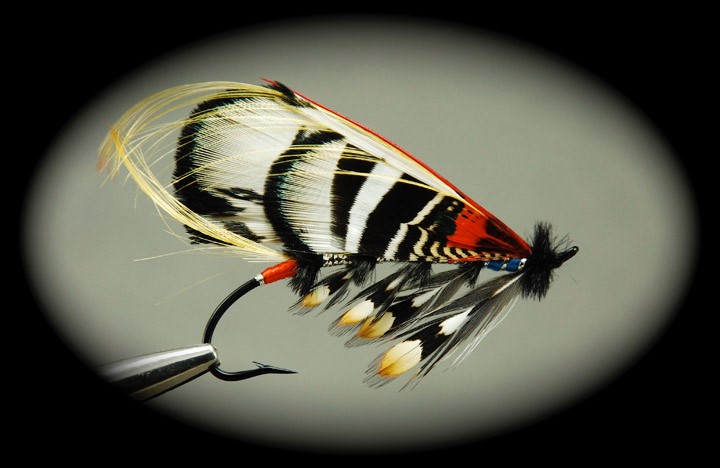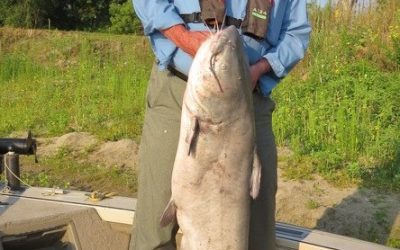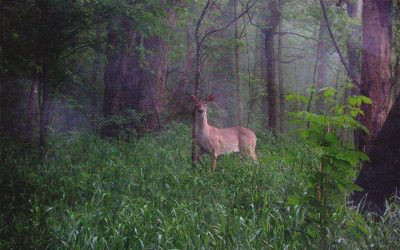Can fly tying be considered an art form? In my opinion, no. But, others disagree. This traditional salmon fly, “The Evening Star” is certainly very beautiful, and I tied it for display, not fishing. Fly tying has been a passion of mine since 1966. (Photo by Larry Myhre. Reprinted from the Sioux City Journal)
The simple act of tying feathers and fur onto a hook has often been described as an art form.
Perhaps, it is.
Some flytiers do, indeed, elevate this practical hobby into some form of art, if only by creating something so beautiful, and yet so functional.
Unlike oil paintings or marble sculptures, probably the most commonly accepted forms of art, the fishing fly is actually created for a use other than simply being admired. It is tied with the intention of catching a fish. Even those flies tied for reasons of display could, if presented in the right place and time, catch a fish.
Traditional forms of art, on the other hand, are created simply to evoke emotional response.
Yet, if I had to choose between the beauty of a well-executed tie of let”s say a fanwing royal coachman, with the bemused smirk of Leonardo da Vinci”s Mona Lisa, I would admit to being more greatly moved by the coachman than the young, Florentine wench.
That, I guess, is my practical side talking.
And now I find myself wandering far off course from the original intentions of this column. I did not set out to write a philosophical treatise on fly tying as an art form.
Suffice it to say, as Norman Maclean did in “A River Runs Through It” that art, in any of its many configurations, is not easily accomplished.
And that certainly sums up good fly tying. It does not come easy.
Yet, I caught a fish on the very first fly I ever tied.
That should give all prospective flytiers hope and move them to proceed into this absorbing and practical pastime.
For those of you about to make the move to buy a vise or to those who have just begun the hopefully long and fun-filled road of fly tying, I would like to provide some anecdotal advice derived from my own sometimes rocky path among the hackles and herls.
Let”s look at things you should do, and why.
Obtain all the catalogs possible from vendors of fly tying equipment and materials. This will give you a good idea of what is out there. Unfortunately, the longer you look at the offerings, the more imperative it will be that you possess them. You will learn that the worst possible reason to begin to tie your own flies is to save money. That is because you will not save money. It is much cheaper to buy your flies. Consider that a really fine dry fly neck is running about $80 right now. A half dozen of those will buy a lot of flies.
Buy a new fly tying vise. The vise you are using now is no good because it is not expensive enough. You should tie flies upon a vise that costs at least $350.
Buy one spool each of every make, size and color of thread that is available. You will need them at some point and the price is probably going to get higher as time goes on.
Try to save a few bucks by picking up dead birds and animals off the road. If you learn something about fur and feather preservation (taxidermy) you can accumulate a large supply of stuff you will never need.
Buy a good set of magnifying visors. You may, as I could at one time, tie a size 20 dry fly without the help of magnifying glasses, but at some point years of staring across water into a setting or rising sun will catch up with you, and help will be needed to see well enough to tie any fly, let alone a size 20.
Try to interest your best fishing buddy in this hobby. With any luck, he or she will become an accomplished tier, and you will be able to give up this frustrating and expensive act of self flagellation.
Try to sell flies professionally. What could be more fun than tying a hundred dozen or so of size 16 Adams dry flies a month?
Set aside one room in your house for fly tying. You will soon need the space anyway, and you won”t embarrass your wife when she has friends over.
Borrow your wife”s cuticle nippers. These $20 manicure items are superb for clipping hanks of deer hair or trimming thread when you finish a fly.
Now, here are some things not to do:
Don”t leave fly hooks lying on the floor around your tying desk. Removing a size 14 2X long nymph hook from the sole of your wife’s foot is something you must try to avoid. If it does happen, however, those magnifying visors will prove once again to be a good investment. try dying your own fly tying materials. If you can”t resist, know that the most easily dyed color is purple. It is achieved by trying to dye something black.
Don”t succumb to the idea of growing your own barred rock roosters in order to obtain a big supply of cheap grizzly hackles. If you must grow roosters, avoid putting 50 of the day-old chicks in your basement for eight weeks before distributing them to mature on farmsteads.
Don”t spend the winter tying an entire box of exquisite dry flies and then leave the box on a streamside rock the next spring for someone else to find and enjoy the fruits of your wintertime labor. Should that happen, however, and you have tied flies professionally at some point, your homeowner”s policy might cover the loss.
That”s enough advice for now. Just remember this.
Never consider anything which comes from your tying vise as art. Leave that to true artists like da Vinci. Many of us think that the Mona Lisa would have looked a lot better in chest waders, and that strange, bemused smile on her face probably came from watching her husband tie flies.
That proves, I guess, that observations alone do not an art critic make. And neither does a well-tied fly make you an artist.






0 Comments